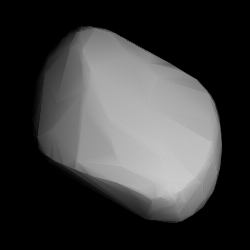Astronomy:6257 Thorvaldsen
 Thorvaldsen modeled from its lightcurve | |
| Discovery [1] | |
|---|---|
| Discovered by | C. J. van Houten I. van Houten-G. T. Gehrels |
| Discovery site | Palomar Obs. |
| Discovery date | 26 March 1971 |
| Designations | |
| (6257) Thorvaldsen | |
| Named after | Bertel Thorvaldsen [1] (Danish sculptor) |
| 4098 T-1 · 1969 TH2 1978 ES5 · 1989 GB7 | |
| Minor planet category | main-belt [1][2] · (inner) Vesta [3] |
| Orbital characteristics [2] | |
| Epoch 23 March 2018 (JD 2458200.5) | |
| Uncertainty parameter 0 | |
| Observation arc | 48.54 yr (17,731 d) |
| |{{{apsis}}}|helion}} | 2.5505 AU |
| |{{{apsis}}}|helion}} | 2.1326 AU |
| 2.3416 AU | |
| Eccentricity | 0.0893 |
| Orbital period | 3.58 yr (1,309 d) |
| Mean anomaly | 167.51° |
| Mean motion | 0° 16m 30.36s / day |
| Inclination | 7.9145° |
| Longitude of ascending node | 30.505° |
| 22.518° | |
| Physical characteristics | |
| Mean diameter | 4.278±0.143 km[4] |
| Geometric albedo | 0.384±0.042[4] |
| Absolute magnitude (H) | 13.7[1][2] |
6257 Thorvaldsen, provisional designation 4098 T-1, is a bright Vestian asteroid from the inner regions of the asteroid belt, approximately 4.3 kilometers (2.7 miles) in diameter. It was discovered during the Palomar–Leiden Trojan survey on 26 March 1971, by Ingrid and Cornelis van Houten at Leiden, and Tom Gehrels at Palomar Observatory in California. The asteroid was named for Danish sculptor Bertel Thorvaldsen.[1]
Orbit and classification
When applying the hierarchical clustering method to its proper orbital elements, Thorvaldsen is a member of the Vesta family.[3] It orbits the Sun in the inner asteroid belt at a distance of 2.1–2.6 AU once every 3 years and 7 months (1,309 days; semi-major axis of 2.34 AU). Its orbit has an eccentricity of 0.09 and an inclination of 8° with respect to the ecliptic.[2] The asteroid was first observed as 1969 TH2 at Crimea–Nauchnij in October 1969. The body's observation arc begins with its official discovery observation at Palomar in 1971.[1]
Palomar–Leiden Trojan survey
Naming
This minor planet was named after Danish sculptor Bertel Thorvaldsen (1768–1844). The official naming citation was published by the Minor Planet Center on 5 March 1996 (M.P.C. 26765).[5]
Physical characteristics
Vestian asteroids have a composition akin to cumulate eucrites (HED meteorites) and are thought to have originated deep within 4 Vesta's crust, possibly from the Rheasilvia crater, a large impact crater on its southern hemisphere near the South pole, formed as a result of a subcatastrophic collision. Vesta is the main belt's second-largest and second-most-massive body after Ceres.[6][7] Thorvaldsen has an absolute magnitude of 13.7.[1][2] As of 2018, no rotational lightcurve of this asteroid has been obtained from photometric observations. The body's rotation period, pole and shape remain unknown.[2]
Diameter and albedo
According to the survey carried out by the NEOWISE mission of NASA's Wide-field Infrared Survey Explorer, Thorvaldsen measures 4.278 kilometers in diameter and its surface has a high albedo of 0.384.[4]
References
- ↑ 1.0 1.1 1.2 1.3 1.4 1.5 1.6 "6257 Thorvaldsen (4098 T-1)". Minor Planet Center. https://www.minorplanetcenter.net/db_search/show_object?object_id=6257.
- ↑ 2.0 2.1 2.2 2.3 2.4 2.5 "JPL Small-Body Database Browser: 6257 Thorvaldsen (4098 T-1)". Jet Propulsion Laboratory. https://ssd.jpl.nasa.gov/sbdb.cgi?sstr=2006257.
- ↑ 3.0 3.1 "Asteroid 6257 Thorvaldsen". Small Bodies Data Ferret. https://sbntools.psi.edu/ferret/SimpleSearch/results.action?targetName=6257+Thorvaldsen.
- ↑ 4.0 4.1 4.2 Masiero, Joseph R.; Mainzer, A. K.; Grav, T.; Bauer, J. M.; Cutri, R. M.; Dailey, J. et al. (November 2011). "Main Belt Asteroids with WISE/NEOWISE. I. Preliminary Albedos and Diameters". The Astrophysical Journal 741 (2): 20. doi:10.1088/0004-637X/741/2/68. Bibcode: 2011ApJ...741...68M.
- ↑ "MPC/MPO/MPS Archive". Minor Planet Center. https://www.minorplanetcenter.net/iau/ECS/MPCArchive/MPCArchive_TBL.html.
- ↑ Nesvorný, D.; Broz, M.; Carruba, V. (December 2014). "Identification and Dynamical Properties of Asteroid Families". Asteroids IV. pp. 297–321. doi:10.2458/azu_uapress_9780816532131-ch016. ISBN 9780816532131. Bibcode: 2015aste.book..297N.
- ↑ Kelley, Michael S.; Vilas, Faith; Gaffey, Michael J.; Abell, Paul A. (September 2003). "Quantified mineralogical evidence for a common origin of 1929 Kollaa with 4 Vesta and the HED meteorites". Icarus 165 (1): 215–218. doi:10.1016/S0019-1035(03)00149-0. Bibcode: 2003Icar..165..215K. https://zenodo.org/record/1259601.
<ref> tag with name "MPC-discoverers" defined in <references> is not used in prior text.External links
- Lightcurve Database Query (LCDB), at www.minorplanet.info
- Dictionary of Minor Planet Names, Google books
- Discovery Circumstances: Numbered Minor Planets (5001)-(10000) – Minor Planet Center
- 6257 Thorvaldsen at AstDyS-2, Asteroids—Dynamic Site
- 6257 Thorvaldsen at the JPL Small-Body Database
 |

